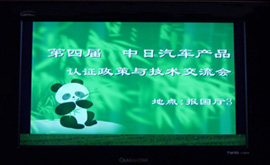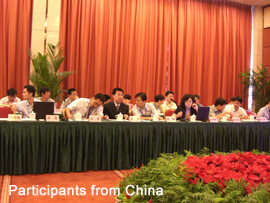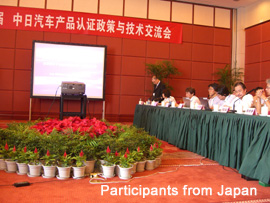| |
Date: |
25-27 July 2007 |
Venue: |
International Convention Hall of Hongzhu Shan Hotel, Sichuan Province, China |
Attendees: |
Japan |
|
JAMA: |
About 25 attendees including Mr. Okada, Chairman of China Overseas Type Approval and Regulations Expert Group; Mr. Nakamura, a member of Pedestrian Protection Expert Group; and Mr. Honkawa, Director of Beijing Office |
|
JASIC: |
Mr. Akiba |
|
China |
| |
About 20 attendees including |
|
Certification and Accreditation Administration of the People's Republic of China (CNCA): |
|
|
Mr. Jin, Deputy Director General of Department for Certification; Mr. Wang, Division Vice Director, Department for Certification; and others |
| |
China Quality Certification Centre (CQC): |
|
|
Ms. Ren, Deputy Director of Certification Department III; Mr. Zhang, Chief of Automobile Section-Product, Certification Department III; and others |
|
and representatives of General Administration of Quality Supervision, Inspection and Quarantine of the People's Republic of China (ACSIQ), Standardization Administration of China (SAC), Ministry of Finance, State Administration of Taxation, and Ministry of Commerce. |
| |
In total, the meeting was attended by about 50 people including the Chinese representative from Europe’s industry association ACEA. |
| |
Summary of the Meeting: |
| (1) |
With regard to China’s CCC certification regulations that are scheduled to be amended/implemented, in-depth discussions were held with CQC for technical issues and with CNCA for administrative issues. |
| (2) |
JASIC introduced its activities since its inception, which include the activities to prepare for and achieve Japan’s accession to the UN 1958 Agreement, the activities at the UN/ECE/WP.29 after the accession, and the activities to adopt the ECE Regulations into the national regulations. In addition, we explained JASIC’s long-term project, which was formulated this fiscal year with the goals to be achieved by fiscal 2015, thereby clarifying the future course of our activities for harmonization of regulations and mutual recognition of certification and asking for China’s cooperation. |
| (3) |
JAMA’s Pedestrian Protection Working Group made a presentation on the gtr for pedestrian protection and the related-assessment. In the presentation, an outline of the 1998 Agreement (to which China has also acceded) was explained. |
| |
Through the Questions-and-Answers Session, we achieved the following results. |
| (1) |
Detailed questions and answers about the UN activities (1958/1998 Agreements) enabled us to deepen Chinese attendees’ understanding. |
| (2) |
We received rigorous questions from China’s certification testing agency, particularly about ECE/gtr adoption procedures and the effectiveness of certificates after adoption of ECE Regulations. |
| (3) |
In questions regarding the gtr on glazing, China showed its interest in the specifics of the relationship between ECE R43 and the gtr, such as the process to harmonize the requirements of the two regulations. |
| (4) |
In relation with regulation harmonization activities, we were able to raise awareness of the importance of solidarity among different Chinese government agencies for administering traffic-safety measures and reducing traffic accidents in China. |
| (5) |
The possibility of China’s participation in UN/ECE/WP.29 meetings was shown when it was proposed that the ccc certification system, being implemented by CNCA, be introduced at the WP.29 meetings. |
| |
It appears that, upon implementation of the new ccc certification system, China is conducting in-depth studies on Europe’s vehicle certification system.
CNCA’s project plans for fiscal 2007 includes not only maintenance of vehicle certification, but also strengthening and maintenance of vehicle parts certification.
For the future expansion of its export of parts and vehicles, China is sufficiently aware of the necessity to discuss mutual recognition of certification within the international framework.
We were able to achieve China’s understanding that it is beneficial for China to adopt the ECE Regulations and mutually recognize certification under the 1958 Agreement, which are our objectives.
We would like to further deepen mutual understanding in the future through actively participating in exchange meetings and other opportunities.
|






